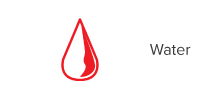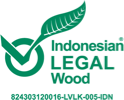
Sustainability
ProductionSustainability is intrinsically linked to our products because we use responsibly sourced, renewable, and recycled fiber. On top of that, we apply innovative design and ensure high manufacturing efficiency in our mills to preserve the environment for our future generations.
Responsible Sourcing
To achieve APP Group' sustainability goals in production, we require all suppliers--both current and potential--to comply with our Forest Conservation Policy (FCP). Additionally, we have also developed the Responsible Fiber Procurement and Purchasing Policy (RFPPP) to guide our suppliers. It provides an overarching framework for the specific processes and criteria that we use in evaluating their compliance with our FCP.
Furthermore, we also developed Supplier Evaluation and Risk Assessment (SERA) tools to facilitate the implementation of the RFPPP across our fiber supply chain. For new suppliers, SERA acts as an initial screening to evaluate the level of risk within a supplier’s operations. Once accepted on our list, these approved suppliers will be subjected to annual SERA evaluations to ensure continued compliance with the FCP.
SERA evaluates suppliers against 12 indicators:
The company, or any of its associated companies in the pulpwood industry, converting natural forest after February 1st, 2013.
Country / region
Tree species
Third-party certification/verification
Chain of Custody System
Legality Compliance
Protection of High Conservation Values or High Carbon Stock
Species protection as listed on the IUCN Red List of Critical Endangered Species and CITES
Company’s respect for traditional civil and human rights
Compliance with ILO Core Conventions
Company’s respect for the health and safety of forest workers
No introduction of genetically modified organisms (GMOs)
We only accept woods from suppliers that have not converted any forest area identified as High Carbon Stock (HCS) as of February 2013.
Based on the risk assessment results, we categorize potential suppliers into "significant risk" or "negligible risk." If a potential supplier is categorized as a "significant risk," it will be required to implement corrective actions (CARs) within an agreed period. Otherwise, it will not be accepted as our supplier.
We upload the summary of the risk assessment report of all potential suppliers on the APP Group monitoring site for public notification, 14 calendar days before we decide on whether or not to accept the potential supplier into our pulpwood supply chain.
Carbon and Energy

Energy efficiency is a key priority for all of our mills. We aim to reduce our CO2 emissions and increase cost efficiency by utilizing renewable fuels to the fullest extent possible when technically or commercially feasible. By using biofuel waste streams at our integrated pulp and paper mills, we have significantly reduced our reliance on fossil fuels.
As part of our SRV 2030 initiative, APP aims to achieve a 25% reduction in energy intensity. As of 2022, we have made significant progress towards this goal, achieving a reduction in energy intensity of 25.31 GJ/tonne-product, which represents a 0.2 GJ/tonneproduct or 5% reduction compared to our 2018 baseline. To achieve this reduction, our mills have implemented a variety of measures, including improving Operation Equipment Effectiveness (OEE), enhancing maintenance programs, conducting energy efficiency measures, adopting new technology, and increasing mill bio-fuel consumption.
In 2022, 59% of our energy needs were met by renewable fuels, representing an increase from 6% compared to our 2018 baseline. We accomplished this by implementing a number of measures, such as increasing the efficiency of our Recovery Boilers (RB), utilizing sludge as a substitute fuel (Waste to Energy) and increasing the use of biomass. In addition, a number of our mills, including Tjiwi Kimia, have obtained Renewable Energy Certification, demonstrating our dedication to using renewable energy sources.
All of our mills are undergoing the approval process for solar panel installation to power their operations. At present, Indah Kiat Perawang, Indah Kiat Tangerang, and Tjiwi Kimia have a total combined solar energy capacity of 18.6 MWp. Based on the results of this current phase, we plan to scale this project in Phase 2, potentially adding an additional capacity of 13.2 MWp.
All mill initiatives related to energy efficiency are registered and tracked as part of the Skill Development Activity (SDA) Program, which aims to enhance operational processes by reducing energy consumption, increasing production efficiency, and minimizing environmental impact. The Olympic System (MBOS) Team oversees and monitors the SDA regularly.
APP closely monitors its emissions via continuous emissions monitoring systems (CEMS) in conjunction with other technologies as part of its GHG reduction program. The CEMS system is installed to comply with government regulations, and we ensure that our emissions are within the regulation limits.
The majority of our emissions consist of Carbon Dioxide (CO2), Sulfur Dioxide (SO2), Nitrogen Oxides (NOx), and fine particles produced by the combustion of fuels. The strategy for reducing these emissions is to make more environmentally friendly fuel choices. We make every effort to use renewable fuels whenever possible and to transition to cleaner non-renewable fuels. In 2022, all mill emission levels met the regulatory requirements for air emissions, in line with our SRV 2030 goals.
APP is committed to reducing emissions by increasing and optimizing the efficiency of every process. To date, the following control programs have been implemented:
• Installing CEMS sensors to monitor exhaust gas emissions online, ensuring that emissions are below the threshold/standard.
• Burning SDT gas emissions in RB units.
• Optimizing ESP control tools to control the burden of exhaust gas emissions.
• Reducing the amount of gas emitted by RB units by replacing wet scrubbers with NaOH.
Water

APP relies heavily on water for its operations, which is utilized for steam generation, heating, cooling, and cleaning. Our method to calculate water withdrawal & discharge is using flow meter installed in the water pump, we calibrate the flow meter periodically.
We acknowledge that water scarcity and stress are significant climate risks and take a company-wide approach to address this issue. Therefore, no water withdrawal in water stress area.
We conduct appropriate risk assessments and integrate their findings into our business planning, continuously working to conserve water by reusing and recycling it as much as possible through our 3R strategy. Our method to calculate water recycle is using theoretical approached from water pump capacity.
APP has set a goal to achieve a 30% reduction in water intensity and 30% lower Chemical Oxygen Demand (COD) emissions per government regulation by 2030. Through the implementation of water efficiency measures at each mill and improved condensate recovery, we were able to achieve a water intensity of 27.9 m3/tonne-product equivalent in 2022, which represents a 16% reduction from our 2018 baseline of 33.0 m3/tonneproduct.
Furthermore, we have made significant progress in reducing COD emissions through improved wastewater operations and the implementation of new anaerobic wastewater treatment plants at Pindo Deli 3 mill. We have monitoring tools for COD values, which have helped us achieve 261 mg/liter as highest COD quality generated from all mill which is below threshold limit 350 mg/liter per government regulation. Our efforts have resulted in a 25% reduction in COD emissions at the lowest of all our mills. Generally, the waste water emission complies with the waste water regulation under MoEF Regulation No. 5 of 2014 on Wastewater but not limited the compliance with the regional level regulation. Our water discharge is taken from fresh water with Total Dissolve Solid (TDS) below 1000 mg /l.
Progress toward water usage efficiency is monitored and discussed at key departmental meetings across all mills. Our performance against targets is communicated to the Management Board, which sets the direction of the topic for each reporting period. To
ensure the sustainability of our business and consider these risks, we have undertaken programs specifically to reduce our freshwater usage. We continuously work to reduce our water consumption by implementing cutting-edge technology and initiatives.
At Tjiwi Kimia, water consumption decreased by 9% due to the implementation of automation pumps and motors, as well as interconnecting the WT unit. In 2022, the mill installed pipes to optimize waste sludge treatment (WWT) and used tapioca residue for WWT.
At Perawang, the fiberline saw water savingsof 11.3 m3/ADT in 2022, while paperlines 8 and 9 experienced water savings from pulp making. Additionally, water previously used as white water in pulp was reused, contributing to further water conservation efforts.
Waste

We are committed to minimising waste and maximising the opportunities to reuse waste materials through the ‘3R’ strategy—reduce, reuse, and recycle. This strategy helps us to maximise the value of resources at each life cycle stage.
The majority of our waste is generated through onsite power production and the pulp and paper making process. To increase our energy efficiency, we turn by-products such as black liquor, bark, and other residues into energy sources to replace the use of fossil fuels at our integrated pulp and paper mills. Furthermore, this means these by-products are diverted from landfill, which along with their use for the generation of power, and reduces the carbon footprint of our mills significantly.
In 2022, APP was able to reduce its waste to landfill tonnage by 1% compared to the 2018 baseline of 515,914 tonnes. This reduction was accomplished through the implementation of waste utilization and maximization initiatives, in addition to efforts to reduce waste production at our mills.
All of our mills maintain solid waste records and submit daily data to the government to identify opportunities for reduction and maximize resource utilization. We collaborate with local governments and ensure compliance among third-party vendors to demonstrate responsible waste management. Our wastewater treatment process minimizes the use of river water, and we monitor hazardous waste to reduce waste output.
APP has implemented control measures for all wastewater generated, which are managed at wastewater treatment (WWT) units. The processing stages start with primary treatment, followed by secondary treatment, post-treatment, and sludge treatment.
• Primary treatment: This initial process is a physical treatment applied to the wastewater by adding PAC and polymer chemicals in the flocculation and coagulation unit. The
wastewater is then settled in the primary clarifier process. The aim is to remove the TSS value from the wastewater.
• Secondary treatment: After settling, the wastewater proceeds to the next stage, which is secondary treatment. This process aims to remove the COD and BOD values from the wastewater, using microorganisms/bacteria. The bacteria decompose the COD and BOD within a specified retention time. Next, the secondary clarifier process separates the wastewater from the bacteria.
Perawang mill works with the local government and IPB University to identify and obtain approval for innovative waste management. The WWTP sludge, bark waste from wood preparation area and bio ash are utilized to create a conditioner that used as a substitute for organic soil amendment raw materials on mineral soils. Perawang mill also utilize bio ash, dregs & grits waste which contains calcium, magnesium, and micronutrient to use as an inorganic soil enhancer in swampy soils.
At Pindo Deli Karawang, 100% of the sludge produced from Pindo 2 was sent to Pindo 3 for recycling into low-grade brown paper. The mill received approval for sludge use in 2021.
IKS achieved a 100% utilization rate for WWT primary sludge as material substitution for paper making.
IKT has its own wastewater treatment system and a special program for waste management called Project Clean Development Mechanism. IKT sends WWT primary sludge to be utilized by Serang mill. By utilizing this waste, Tangerang mill can save waste disposal costs around 1.1 million per year and Serang mill receives raw material.
Tjiwi Kimia achieved a 100% reuse rate for B3 sludge, which was recycled for fiber production. The mill also implemented a 3R Waste Pallet measuring 5,596 m3. The transformation of white paper into brown paper presented a wastewater treatment challenge for the mill, which was resolved by constructing two secondary clarifiers and an anaerobic plant.
Certification
We have expanded the hectarage of our pulpwood supply chain that is covered by formal third-party certification. We use certification as a ‘chain of custody’ assurance tool that enables us to trace the fiber that we use to a well-managed source.

